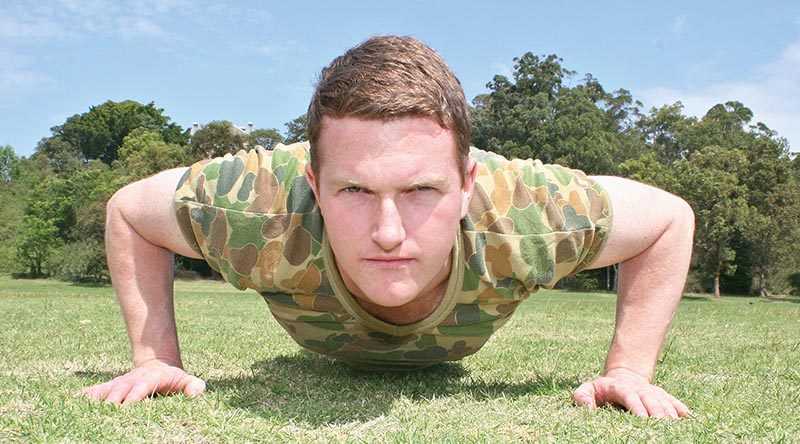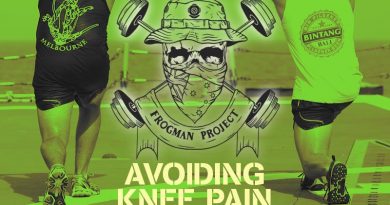Military Fitness – Part 29


Despite not being psychic, I can take a fairly good guess at a few things about you simply because you are reading this column.
Number 1 – you are interested in increasing your fitness, most likely because it’s important for your job and your sports performance.
Number 2 – you have probably tried a lot of training programs over the years and,
Number 3 – despite increasing effort on your behalf, many of these programs no longer deliver the results in strength, speed or endurance that you are after.
If that sounds familiar then read on, because I am about to outline a simple method for busting through training plateaus that has the potential to smash all of your previous training records.
 Couch to Commando by Don Stevenson is a 165-page e-book with programs in 6 different levels to progress anyone from couch potato to commando candidate.
Couch to Commando by Don Stevenson is a 165-page e-book with programs in 6 different levels to progress anyone from couch potato to commando candidate.
20% of proceeds from the sale of this e-book will be donated to Soldier On
The problem?
Very simply, most people attempt to become better at doing things by doing more work.
The theory is that, if you can run 3km one week, 4km the next, 5km the next and so on you’ll get better at running, or if you do three sets of 20 pushups one week and three sets of 25 the next that you’ll get better at doing pushups.
Unfortunately, as the volume of training increases, fatigue causes the intensity to drop off and this leads to a lower quality of training.
For example, if you are doing pushups, you might do a couple of warm up sets and then try to do five sets of 40 reps.
But, by the third set, fatigue means that you can’t complete all the reps and this means that you don’t get the stimulus required to push your endurance further.
Another example is the common prescription for strength exercises of three sets of 12 or five sets of eight and so on. Maintaining quality effort across so many sets and reps becomes very hard and lowers the peak intensity of the training load.
In order to improve these training plans it turns out that you need to change your perspective on training slightly and adopt some counterintuitive set, rep and loading schemes to get the best results.
I want to outline a way of structuring workouts to provide an adequate training volume while optimising the peak training load for continued progress without leading to burnout.
This type of programming relies on manipulating the way the nervous system, muscles and cardiovascular systems respond to imposed stress.
At the heart of this structure is what I would call loading waves.
The main idea with this type of training is that, within a training session, it can be advantageous to not only progressively increase the training load but also to decrease and increase the load several times for a given exercise.
This type of loading pattern has several surprising advantages over simple ascending or straight loading across a number of sets.
- A relatively high volume of training can be completed without excessive fatigue
- Peak load in each session can be higher which leads to the best improvements in fitness
- Instead of the best performance occurring early in the workout, top performance often occurs in the last set of a workout and is often noticeably superior to performance in a straight ascending program.
EXAMPLES:
Ok, so let’s look at two examples that will be familiar to most readers. In each case I am going to list a typical workout used by an intermediate trainee and then show how a superior effect can be achieved with loading waves.
Pushups – typical workout
Warm up with a couple of easy sets and then perform five x 30 reps. The first two sets might be easy, the third moderately difficult and the last two sets on the limit.
Total volume is 150 reps and peak load is 30 reps.
Improved loading wave
Warm up and perform the following rep pattern – 15, 25, 35, 20, 30, 40.
Note that the overall volume is higher at 165 reps but that the back-off to 20 and 30 reps before the final set of 40 allows recovery and leads to a higher peak load to be handled.
Squats – strength training
Typical workout in ascending pyramid fashion.
60kg x 12 reps, 70kg x 10 reps, 80kg x eight reps, 90kg x six reps, perhaps another set of five or six at 90kg.
Improved loading wave
Warm up with 60kg x five reps, 70kg x five then 90 x five, 100 x three, 105 x two, 90 x five, 105 x three, 110 x two.
Note that in this workout the peak load is much higher, but that the 110kg for two reps will feel easier than the 105kg x two despite coming after two more sets including 105 for three!
This is because the stimulation of the nervous system from the initial group of three sets allows for the final set to be the best set because the overall training load is not excessive and therefore not too fatiguing, and because the nervous system is then fully ‘fired up’ for a big effort.
These principles can be applied to most big barbell and bodyweight exercises and can be used for cardio training too.
The main thing is not to make the early sets too hard and make sure to use reasonably large jumps is reps and load between sets.
.
.
.
.
.

.
.






